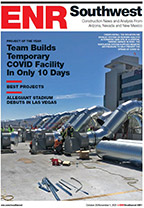CityCenter is Las Vegas� grandest, most extravagant Strip production yet, encompassing 18 million-sq-ft of high design shops and restaurants, hotel and homes. The $8.5 billion, seven-building complex is the equivalent of nine Empire State buildings. It�s also the largest privately financed project in United State history. Construction required a well-coordinated, herculean effort from project contractor Perini Building Co., with Tishman Construction Corp. as executive construction manager and Gensler was executive architect.
"We believe the massive scale and private funding of CityCenter sets new records for a building construction project of any kind in the United States," says Perini President Craig Shaw. "This is a world-class project."
A team of 11,000 craftsmen � one-third of Southern Nevada�s total building trades � recorded over 50 million man-hours to complete the massive development. Crews worked three shifts, 24 hours a day, seven days a week. And there was a professional staff of 500 people. It�s more people than worked on the Hoover Dam. CityCenter�s construction payroll ran up $27 million a week or $100 million a month.
�CityCenter�s toughest challenge was the planning and orchestration that needed to take place. There was no onsite storage, so we needed to carefully schedule and sequence delivery of building materials. Some items had lead times between six to 12 months or longer for fabrication and delivery,� says Shaw. �We planned and strategized a year before putting a shovel into the ground.�
Perini adopted a divide and conquer approach. CityCenter is broken into three major building blocks, each with its own schedule and team project managers, superintendents and engineers. A friendly but fierce rivalry existed between block teams, each vying for bragging rights and racing against one another to finish schedule milestones. Roughly 800 buggy carts helped move construction staff around the 67-acre jobsite wedged between the Monte Carlo and Bellagio resorts along Las Vegas Boulevard.
Block A consists of the 600-ft-tall, 4,004-room Aria Resort and Casino, which is CityCenter�s largest building. The 4 million-sq-ft high-rise consists of two curvilinear glass towers with a 300,000-sq-ft convention center, a 1,800-seat theater, and a 215,000-sq-ft pool area. ARIA is designed by Pelli Clarke Pelli Architects, the New Haven, Conn.-based firm headed by Cesar Pelli who created the Petronas Towers in Kuala Lumpur, Malaysia, which held the world�s tallest building title from 1998 to 2004. Dallas-based HKS Inc. is the architect-of-record.
Block A also includes an 11-story, 7,200-space parking garage along Frank Sinatra Drive, which was the first thing built at CityCenter. It replaced the existing parking lot onsite for Bellagio employees, providing new parking for them as well as construction craftspeople. It additionally enabled Perini to clear site for tower foundation work, which required more than 10,000-cu.-yds of concrete and set the groundwork for Aria as well as adjacent structures in Block B, including a 55,000-sq-ft central plant and a new elevated Harmon Road roadway with pedestrian walkways. Block B additionally has the 57-story, 1,495-room Vdara tower, designed by award winning New York architect Rafael Vi�oly. The 1.5-million-sq-ft high-rise consists of three crescent-shaped glass volumes grouped together as a single building.
CityCenter�s remaining components are grouped together in Block C. There is the 47-story, 400-room Mandarin Oriental Las Vegas with 227 condominiums; the 400-room Harmon Hotel; the 37-story leaning Veer Tower that each have 335 residences and the 500,000-square-foot Crystals retail and entertainment district, which could be CityCenter�s most complex building.
Crystals is designed by architect Daniel Libeskind who is also the master-plan architect at the World Trade Center site in Lower Manhattan. Schuff Steel Co., the contractor who built Crystal�s framework, spent 12 months developing a three-dimensional project model that generated 15,000 detailed shop drawings used for construction. The building has no right angles.
�Planning and building Crystals was the most complex project we have built in our 33-year history,� Schuff project executive Dave Ferrell said. �It does not follow a pattern or have any repetitive placements of steel.�
Crystals is sheathed in overlapping quartz-shaped metal and glass panels. The roof is made up of thousands of pieces of leaning columns, curving trusses and straight members that don�t line up with any other piece of steel. The building actually has 19 separate roofs that intermingle and overlap one another. Crystals required 16,455 pieces of uniquely fabricated steel that was pieced together at 52,766 connections. It took two years and 14 shops to fabricate all the necessary steel, which was delivered to the job site by 1,433 trucks. The project employed five cranes and 150 ironworkers who each averaged 250,000 man-hours of work.
Yet Perini managed both man and machine to successfully reach the finish line. CityCenter had 250 subcontractors and 2,000 vendors and suppliers. It had its own concrete plant onsite. There were 50 cranes and 50 man-lifts, 150 forklifts and 2,500 scissor lifts. The epic-sized effort resulted in a brilliant constellation of buildings.
�CityCenter bridges the vitality of Las Vegas with the experiences travelers seek when they visit great cities around the world,� CityCenter President and CEO Bobby Baldwin said in a statement. �It is an evolutionary destination that aims to transform Las Vegas as a new symbol at its core, like the Guggenheim in Bilbao, the Pompidou in Paris or the Sony Center in Berlin.�



Post a comment to this article
Report Abusive Comment